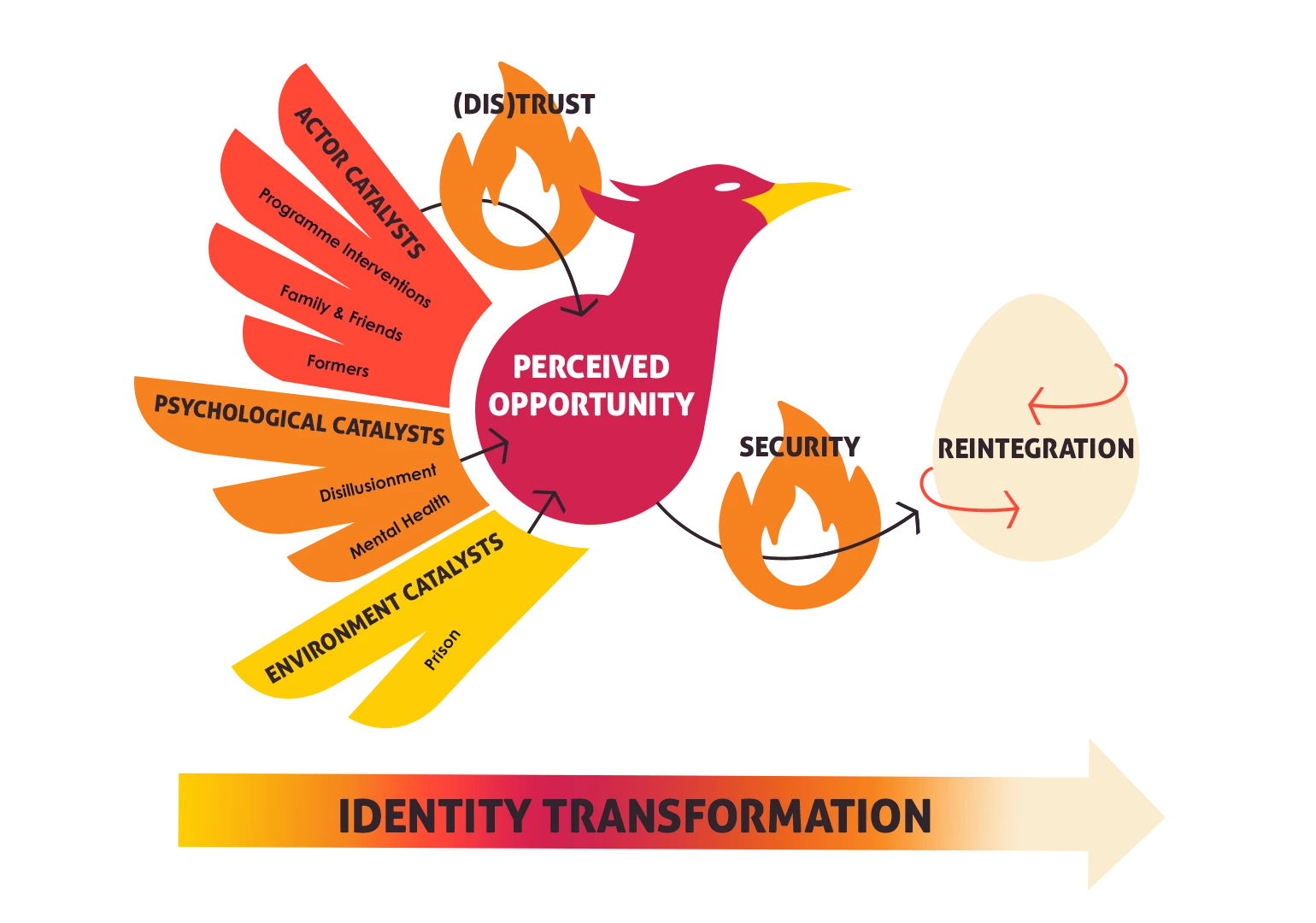Model synopsis
In a review of disengagement and deradicalisation literature from 2017 to 2020, we identified 11 major themes: Opportunity, Disillusionment, (Dis)trust, Family and friends, Prison, Identity, Programme interventions, Formers, Security, Mental health, and Reintegration.
Many of these themes have been flagged as significant factors in disengagement and deradicalisation before, though this is the first time they’ve been identified as a collective and this systematic approach allowed further analysis to suggest a new model for understanding disengagement and deradicalisation processes.
Within these themes, we identified three catalysts: actor, psychological, and environmental, that play interconnected roles in an individual’s disengagement and/or deradicalisation. The themes relating to each catalyst category are as follows:
Catalysts
- Actor catalysts: Family and friends, Programme interventions, Formers
- Psychological catalysts: Disillusionment, Mental health
- Environmental catalyst: Prison
In our review, prison was the only environmental catalyst we identified. However, with further assessment, a wider variety of environmental catalysts may also be identified.
Filters
The catalysts’ impact can either be positively or negatively affected by a series of filters:
- [Dis]trust
- Perceived opportunity
- Security
These filters play the role of refining which individual will successfully go through the disengagement/deradicalisation processes. The filtering variable of (dis)trust is critical regarding the actor catalyst(s). If the individuals promoting or supporting disengagement/deradicalisation are trusted, this leads to a greater likelihood of a positive outcome. In contrast, if distrusted, this can lessen the possibility of successful disengagement/deradicalisation.
Even with the positive impact of actor, psychological, or environmental catalysts, an individual will not be likely to disengage/deradicalise unless they are provided with a credible, positive, and sustained opportunity. However, even with the presence of this perceived opportunity, if there are significant and credible security concerns for the individual, then the process leading to successful reintegration may be impeded. This could, for example, be a threat of violence, or a perceived threat of violence, towards the disengaging individual and their family from members or allies of the group they are considering leaving.
The studies we reviewed demonstrated that the individual is going through a gradual identity transformation throughout the whole process – a central aspect of the Phoenix Model. The role of identity across the studies varied on an individual basis and with different issues flagged, including:
- The rejection of an existing extremist identity
- The search and elevation of an alternative identity
- The transformation of a militant identity into a peaceful identity, embracing many similar values.
The Phoenix Model posits a central role for identity transformation in the process of change. The significance of other factors is related to how they can a) catalyse such change, b) provide opportunities for it to occur, or c) present blockages to its progress.

The Phoenix Model
The model was named the Phoenix Model as identity transformation (particularly in terms of the rebirth of pre-existing elements of identity) provides the foundation of the disengagement and deradicalisation processes. These pre-existing elements of identity had been subsumed or dominated by elements supportive of or embedded within the individual’s life as a terrorist or violent extremist. One of the key findings of our review was that the re-emergence of the alternative identities (due to a variety of potential causes) appears to be a fundamental factor in the process of change.
In mythology, the phoenix is frequently a symbol of rebirth and renewal from the ashes of an old life. Such symbolism seemed especially apt for this new model, centred as it is on the concept of identity transformation, where the re-emergence of often old, subsumed identity elements (or the creation of an entirely new identity) provides the foundation for a move away from life as an active terrorist or violent extremist.
As highlighted in the model, such transformation can be facilitated by a range of catalyst factors that successfully pass through the identified filters; these sometimes work together and sometimes work in isolation. The evidence suggests that these processes are usually common in the lives of most terrorists and extremists. Disengagement or deradicalisation, however, is not necessarily inevitable.
It is worth noting that the model reflects the significant findings from recent research in this area, but we are not arguing that other factors do not play a role in these processes. It is likely that other factors currently lack good evidence and data but will later be identified as playing a role. Yet, the strength of this new model is that it is solely derived from a systematic review of the strongest contemporary research.
Future research may highlight other relevant factors, which will lead to the significant refinement of our understanding of the role of the factors already identified and incorporated here. For now, however, we have found that these are the factors with the most robust empirical support.
Insights
The Phoenix Model offers a range of potential insights and applications in terms of policy and practice. At a fundamental level, it highlights factors found to facilitate the disengagement and deradicalisation processes. The model also suggests how these factors can interact and flags issues that should be considered when designing or assessing the impact of initiatives in this area.
Overall, the model argues for a key role for identity dynamics and that this can be a critical factor in disengagement and deradicalisation processes. Importantly, the nature of these dynamics and outcomes varies on an individual basis. The research suggests that it is crucial to consider identity – and what happens to it – when considering the design and evaluation of interventions in this field.
The model also supports the development and use of disengagement and deradicalisation programmes with terrorist and extremist offenders. The systematic review found that these interventions generally show positive impacts in a majority of cases. However, they do not ‘work’ in 100% of cases, and evidence is currently lacking on what elements of such programmes are the most effective. This needs to be a priority for future research.
Next steps
While there is much to be encouraged about in considering the Phoenix Model, caveats remain. In particular, the quality of the research data in this area (though notably improved in recent years) still lags behind the standards common in many other areas, such as our understanding of desistance processes with non-terrorist offenders.
Though a large number of studies were initially identified as relevant, ultimately, very few made the quality benchmark criteria we set. Even among these studies, with a few exceptions, we note that the majority relied on qualitative methodological approaches such as semi-structured interviews, autobiographical analysis, and case study analysis. With one notable exception, research rarely made use of comparison or control groups.
We are not arguing that these research methodologies are not valuable, on the contrary. However, for our understanding of disengagement and deradicalisation to continue developing, there needs to be greater variety and sophistication in our methodological and analytical approaches. Addressing such concerns is one area that requires significant attention in future research.
The strength of this new model is that it is solely derived from a systematic review of the strongest contemporary research.
There are several important subjects on which data are currently lacking. For example, there is limited information available on the timing of disengagement and deradicalisation processes. Some research presents the length of time this process can take, however, we need more in-depth knowledge about this timing. It would greatly benefit those designing disengagement and deradicalisation programmes to have an understanding as to whether there are, for example, significant transition periods or windows for supporting change.
Further, though the initial evidence in this area is encouraging, more independent assessments are needed of the impact of programmes designed to facilitate disengagement or deradicalisation. Such programmes frequently come in for harsh public scrutiny around their effectiveness. The available evidence, however, is generally limited and often of patchy quality. In particular, the current state of knowledge is very poor at identifying what elements of the different programmes have the most impact. As most interventions comprise multiple elements, this creates uncertainty over what works best overall, and there remains a pressing need for robust evaluations of these interventions.
Another critical issue that needs more attention is the risk of backsliding. Current research does not provide much insight into the processes and risks around apparently disengaged or deradicalised individuals later reengaging with terrorism. Relapse and recidivism occur but appears to be uncommon. A growing body of research suggests that recidivism rates for terrorist offenders, for example, are comparatively low. However, a more systematic understanding of the factors involved in backsliding is clearly needed.
An empirically led understanding of why and how individuals reengage with terrorism would allow practitioners to develop more resistant support structures to assist in developing a more sustainable disengagement process.
Read more
- Renard, T. (2020). Overblown: Exploring the Gap Between the Fear of Terrorist Recidivism and the Evidence. CTC Sentinel, https://bit.ly/3iTXQRM
- Silke, A., Morrison, J. (2020). Re-Offending by Released Terrorist Prisoners: Separating Hype from Reality. ICCT Policy Brief, The Hague. https://bit.ly/3FAgdoJ
- Taylor, C., Semmelrock, T., McDermott, A. (2019). The Cost of Defection: The Consequences of Quitting Al-Shabaab. International Journal of Conflict and Violence, 13, a657–a657. https://bit.ly/3BD4d3p
Copyright Information
As part of CREST’s commitment to open access research, this text is available under a Creative Commons BY-NC-SA 4.0 licence. Please refer to our Copyright page for full details.
IMAGE CREDITS: Main Photo by By LightField Studios | Shutterstock.com






